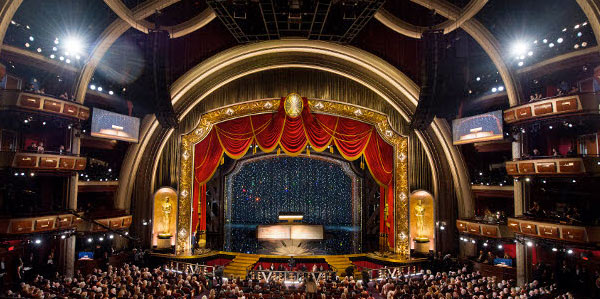Concert Sound Is Decidedly LoFi: Part I
It was my first visit to the Dolby Theater last Tuesday evening when I went to the Neil Young concert. It’s a very elegant space with 4 levels, a couple dozen side boxes and excellent acoustics. Located at the corner of Hollywood Boulevard and Highland Avenue in the heart of Hollywood, it’s become well known for hosting the American Idol competition and numerous awards shows.
The theater is equipped with two large speaker arrays hung on the left and right high above the stage. This arrangement, which has become increasingly popular in modern theaters, provides phase coherent, stereo amplified sound to be delivered across the entire space. The speaker arrays are made up of multiple individual speaker cabinets that are angled toward the different areas of the hall.
In the middle of the hall is a small area from which the sound and lights are controlled. Our seats were just off to one side from the FOH (front of house) mixing position so I had a pretty good representation of the overall mix. I didn’t recognize the brand of the equipment that was being used but it was definitely a digitally controlled analog desk. As opposed to the strictly analog console of the past, current consoles pass analog signals through VCAs (voltage controlled amplifiers) and other processing that are “automated” by an on board computer system. The mixer can preset all of the levels and processing on a “song by song” basis and simply “recall” the appropriate preset as the concert proceeds. Gone are the days when the mixer controls the levels of all of the inputs manually throughout the show. ..although an override is always possible.
I’ve done a lot of live concert sound in my career (the Cal Art Contemporary Music Festival, the Ojai Music Festival, the 1984 Olympic Arts Festival and plenty of work at small clubs) and am quite familiar with the standard procedures involved in providing amplified sound to an audience. When there’s a lot of different instruments or voices to control AND a different ensemble playing each composition or song, things can get quite complex. This was not the case on Tuesday during the Neil Young concert.
It was a solo show. Neil accompanied himself on a few different guitars and a “bantar” (combination banjo and guitar), two different pianos, small organ and harmonica. There were several microphones on stage but he used a small head mounted, high-quality performance mike. He could…and did…move around the stage and was able to be heard no matter where he went. He frequently walked to an iconic carved wooden Indian named “Woody” to discuss how the show was going.
The vocal microphone was connected to a wallet-sized transmitter, which then broadcast the sound of his voice and harmonica to a receiver located at the FOH position. These units are actually two receivers built into a single housing can are called “diversity” wireless system. The idea is to have a redundant receiver system to minimize any dropouts. The received with the best signal is routed to a channel of the console.
When Neil sings the sound of his voice doesn’t come from the center of the stage, it comes from the speakers flying 40 feet above him. That’s always been a problem for me…it just doesn’t match the visuals. I understand it’s the reality of a live concert but this was all about an intimate living room performance.
Part II comes tomorrow…


Throughout the years I have enjoyed cartoons depicting audiophiles at a concert analyzing the audio as if they were analyzing a home playback setup: “Imprecise imaging…lack of definition here or there…balance is off.” The joke was supposed to be about those of us who cannot turn “it” off and enjoy the show. But in the case Mark describes this is no joke…it is likely you could get a better audio experience at home. You will miss out on an historical moment and the uniqueness of that evening’s show. I’m interested to see if Mark describes a remedy in part two!
I did enjoy the show…very much, in fact. But I can’t help but think how I would have handled the engineering differently.